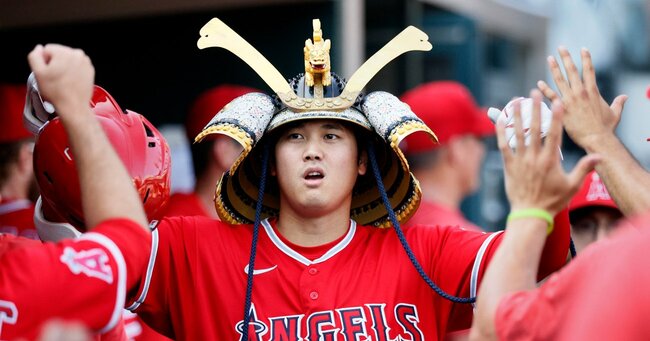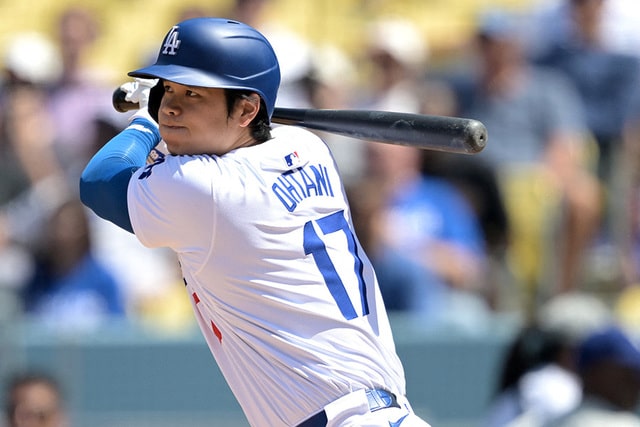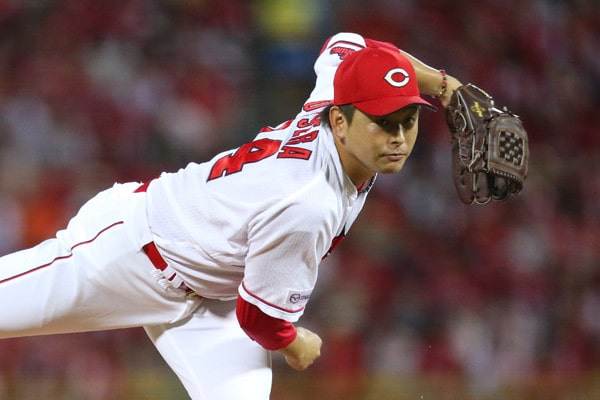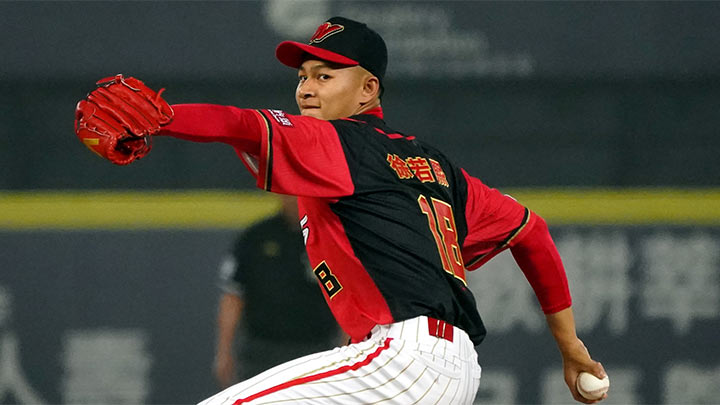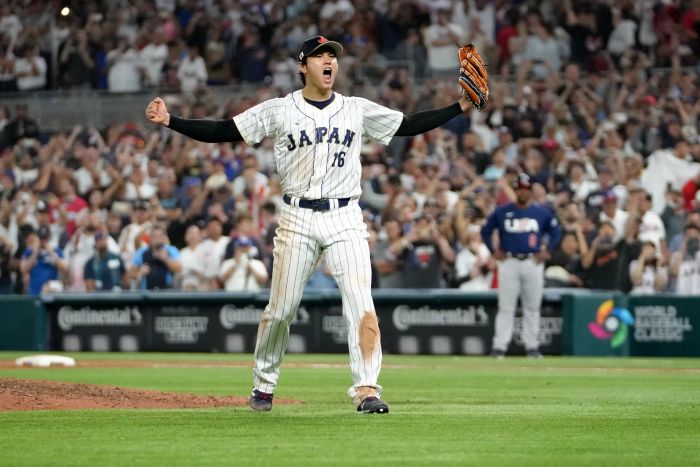
Shohei Otani became one of the leading players in Japanese baseball through his talent and hard work.
His professional career began with the Hokkaido Nippon-Ham Fighters, where he was loved by many fans.
In this article, we will focus on Shohei Otani’s Nippon Ham era and take a closer look at his uniform number changes and achievements.
Let’s take a look back at his path from turning professional to playing in the major leagues, and explore his achievements and the meaning behind his uniform number.
Let’s unravel the details of Shohei Otani’s performance during his time with the Nippon-Ham Fighters.
Now, let’s take a look at the story that begins with his joining.
目次
- 1 Shohei Otani joins Nippon-Ham Fighters
- 2 Changes in Shohei Otani’s jersey number
- 3 Summary of results during Nippon-Ham era
- 4 Details of Shohei Ohtani’s pitching results
- 5 Details of Shohei Ohtani’s batting performance
- 6 Highlights and awards from his time with Nippon Ham
- 7 Influences and legacy of Shohei Otani’s Nippon Ham era
- 8 Interacting with fans and the importance of uniform numbers
- 9 Shohei Otani’s results and future outlook
- 10 Looking back at the Nippon Ham era
Shohei Otani joins Nippon-Ham Fighters
Shohei Ohtani’s joining the Nippon-Ham Fighters was surprising news to many people.
Otani had hoped to play in the major leagues after graduating from high school, and the Hokkaido Nippon-Ham Fighters selected him with their first draft pick.
The team prepared special materials for Ohtani called “Guidelines to Your Dreams” and persuaded him that playing for Nippon-Ham was the best choice for his career.
This document moved Otani’s heart as it showed him a concrete plan to make his dream come true.
How Shohei Otani joined the team
Shohei Otani played an active role at Hanamaki Higashi High School in Iwate Prefecture and attracted the attention of professional scouts from his high school days due to his overwhelming talent.
In particular, his ability in both pitching and hitting was highly praised as a “dual swordsman.”
Otani initially announced his intention to play in the major leagues, but the Hokkaido Nippon-Ham Fighters drafted him with the first pick and began negotiations to join the team.
Nippon-Ham manager Hideki Kuriyama and front staff gave a detailed presentation to Otani called “Signposts to your dreams.”
The presentation specifically outlined the development opportunities that Ohtani would gain from playing for Nippon Ham, as well as the path to a future challenge in the major leagues.
In particular, it was promised that an environment would be created for Ohtani to play as a “two-way player,” which supported Ohtani’s decision.
Uniform number in the first year of joining the team and the reason why it was chosen
In Shohei Otani’s first year with the Nippon-Ham Fighters, his jersey number was decided to be 11.
This number was used by Nippon Ham’s legendary pitcher, Yu Darvish, and had great meaning to Ohtani as well.
Darvish, like Ohtani, was a player who received high praise for both his pitching and hitting, and inheriting Darvish’s jersey number was a great source of pride and pressure for Ohtani.
Otani demonstrated his talent from his first year with the team, showing success as both a pitcher and a batter.
His fastball, in particular, could reach over 160 km/h, surprising fans and the media with its incredible speed.
Furthermore, he also hit a home run as a batter, showing his potential as a “dual-wielding” player.
In this way, Shohei Ohtani began his career with the Nippon-Ham Fighters and laid the foundation for his future challenge in the Major Leagues.
The process from his joining to the selection of his jersey number in his first year foreshadowed his future success and gave many fans hope.
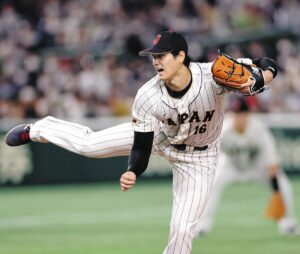
Changes in Shohei Otani’s jersey number
Shohei Ohtani wore jersey number 11 throughout his career with the Nippon-Ham Fighters.
This number is very meaningful to Otani, as he inherited it from Yu Darvish, who was active as the ace of Nippon Ham.
Let’s take a closer look at the history of his jersey number and its impact.
Meaning and influence of jersey number 11
When Shohei Ohtani turned pro in 2013, he chose uniform number 11.
This number was worn by Yu Darvish, who was once the ace of Nippon-Ham and went on to achieve success in the major leagues.
Taking over Darvish’s jersey number was a huge pressure for Ohtani, but even more so, it was a source of pride and motivation.
The number 11 holds a special meaning for Nippon Ham Fighters fans.
With Ohtani taking over this number, fans’ expectations for him have increased even more.
Otani himself also tried to live up to the expectations of his fans by showing performance worthy of this number.
His success in both pitching and hitting has made his jersey number 11 shine as a symbol of “dual-wielding.”
Otani had great results in his first year with Nippon-Ham, and continued to improve every year thereafter.
In particular, in 2015, he won 15 games as a pitcher and hit 22 home runs as a batter, showing success worthy of uniform number 11.
The bond with fans created by the uniform number
The number 11 on his back helped create a strong bond between Shohei Otani and his fans.
This number, which he inherited from Yu Darvish, not only had a special meaning for Ohtani, but also had a special symbolism for his fans.
Fans came to the stadium wearing uniforms with the number 11 on their backs and cheered on Otani’s success.
Otani’s play continued to impress and excite fans.
His brilliant play on both the pitching and batting sides captivated many fans and sparked “Otani fever” throughout Japan.
In particular, there were a series of events that further deepened the bond with fans, such as winning the league MVP award in 2016.
Otani himself also values fan service, actively holding autograph sessions and taking photos after games.
Through these activities, a strong bond was formed between him and his fans.
Uniform number 11 has become a special number that symbolizes Shohei Otani to fans, and its popularity continues unabated to this day.
In this way, uniform number 11 has an important meaning for Shohei Otani, and it has become a symbol of his success during his time at Nippon Ham.
This number also created a strong bond between him and his fans.
Otani’s jersey number 11 from his time with Nippon Ham continues to hold a special place in his career.

Summary of results during Nippon-Ham era
Shohei Otani fully demonstrated his outstanding talent during his time with the Nippon-Ham Fighters.
He breathed new life into Nippon Professional Baseball (NPB) as a two-way player in pitching and hitting, and attracted many fans.
Below, we will take a closer look at Shohei Ohtani’s annual results and major results in both pitching and batting.
Results by year
Shohei Ohtani made his professional debut in 2013 and spent five seasons with the Nippon-Ham Fighters until 2017.
The results for each year are as follows.
2013
- Pitching record : 13 games pitched, 3 wins, 0 losses, ERA 4.23, pitches 61.2, strikeouts 46
- Batting results : 77 games played, batting average .238, 3 home runs, 20 RBIs, 4 stolen bases
2014
- Pitching record : 24 games pitched, 11 wins, 4 losses, ERA 2.61, pitches 155.1, strikeouts 179
- Batting statistics : 87 games played, batting average .274, 10 home runs, 31 RBIs, 1 stolen base
2015
- Pitching results : 22 games pitched, 15 wins and 5 losses, ERA 2.24, pitches 160.2, strikeouts 196
- Batting results : 70 games played, batting average .202, 5 home runs, 17 RBIs, 1 stolen base
2016
- Pitching record : 21 games pitched, 10 wins, 4 losses, ERA 1.86, pitches 140.0, strikeouts 174
- Batting results : 104 games played, batting average .322, 22 home runs, 67 RBIs, 7 stolen bases
2017
- Pitching record : 5 games pitched, 3 wins, 2 losses, ERA 3.20, pitches 25.1, strikeouts 29
- Batting results : Appeared in 65 games, batting average .332, 8 home runs, 31 RBIs, 0 stolen bases
Major achievements in both pitching and hitting
Shohei Ohtani’s major achievements in both pitching and hitting during his time with Nippon Ham show how good of a two-way player he was.
Pitcher performance
As a pitcher, Ohtani pitched in a total of 85 games over five seasons, posting a record of 42 wins, 15 losses, an ERA of 2.52, and 624 strikeouts.
In particular, in the 2015 and 2016 seasons, his ERA was 2.24 and 1.86, respectively, showing that he was one of the top pitchers in the Japanese professional baseball world.
Also, in 2015, he recorded an overwhelming number of strikeouts with 196, proving his pitching ability.
Batting performance
As a hitter, Ohtani also achieved great results.
He appeared in a total of 403 games over five seasons, posting a .286 batting average, 48 home runs, 166 RBIs, a .358 on-base percentage, and a .500 slugging percentage.
In particular, in the 2016 season, he achieved career highs with a batting average of .322, 22 home runs, and 67 RBIs, proving that he is also a top-class batter.
Shohei Otani’s time with Nippon Ham was an important period that laid the foundation for his subsequent challenge in the Major Leagues.
His excellent performance in both pitching and batting breathed new life into the world of Japanese professional baseball, inspiring and exciting many fans.
Shohei Otani, who has achieved such great results, will continue to be expected to continue to excel in the future.

Details of Shohei Ohtani’s pitching results
Shohei Ohtani achieved outstanding results during his pitching career with the Nippon-Ham Fighters.
His pitching record clearly shows how good of a player he is.
Below, we’ll take a closer look at his wins/losses, ERA, and strikeout/walk stats.
Wins/losses and defense rate
Shohei Otani’s performance as a pitcher during his time with Nippon Ham was extremely good. Here are his wins/losses and ERA over his career.
2013
- Number of appearances : 13 games
- Wins and losses : 3 wins, 0 losses
- ERA : 4.23
In his first year as a professional, Otani pitched in 13 games and had a record of 3 wins and 0 losses. His ERA was 4.23, which was a decent performance for a rookie, and foreshadowed his future success.
2014
- Number of appearances : 24 games
- Number of wins and losses : 11 wins and 4 losses
- ERA : 2.61
In his second year, Ohtani pitched in 24 games, recording 11 wins and 4 losses. His ERA also improved significantly to 2.61, establishing himself as an ace pitcher.
2015
- Number of appearances : 22 games
- Number of wins and losses : 15 wins and 5 losses
- ERA : 2.24
2015 was a breakthrough year for Otani. He pitched in 22 games and had a record of 15 wins and 5 losses, with an even better ERA of 2.24.
2016
- Number of appearances : 21 games
- Number of wins and losses : 10 wins and 4 losses
- ERA : 1.86
2016 was a particularly bright year in Otani’s career. He pitched in 21 games, posting an astonishing record of 10 wins, 4 losses, and an ERA of 1.86.
2017
- Number of appearances : 5 games
- Number of wins and losses : 3 wins and 2 losses
- ERA : 3.20
In 2017, due to injuries, his number of appearances decreased, but he still pitched in five games and had a record of three wins and two losses.
Strikeout and walk statistics
Shohei Ohtani’s distinctive feature as a pitcher is his overwhelming ability to strike out.
Below are the statistics for strikeouts and walks allowed for each year.
2013
- Strikeouts : 46
- Walks allowed : 33
In his first year as a pro, Otani had a decent record with 46 strikeouts, but he also gave up 33 walks.
2014
- Strikeouts : 179
- Walks allowed : 57
In his second year, his number of strikeouts increased significantly, reaching 179. On the other hand, the number of walks allowed increased to 57, but this was more than covered by strikeouts.
2015
- Strikeouts : 196
- Walks allowed : 46
In 2015, the number of strikeouts further increased to 196. His number of walks allowed also improved to 46, showing an improvement in his ball control.
2016
- Strikeouts : 174
- Walks allowed : 45
In 2016, he maintained stable ball control with 174 strikeouts and 45 walks.
2017
- Strikeouts : 29
- Walks allowed : 19
In 2017, he recorded 29 strikeouts even though he only pitched in a small number of games, but his number of walks was slightly higher at 19.
Shohei Ohtani’s pitching performance during his time with Nippon Ham shows his outstanding ability, especially his high number of strikeouts.
His talent as a pitcher was among the top in the Japanese professional baseball world, and became the basis for his subsequent challenge to the major leagues.

Details of Shohei Ohtani’s batting performance
Shohei Otani achieved outstanding results not only as a pitcher but also as a batter during his time with the Nippon-Ham Fighters.
His batting record shows how good a “two-way” player he was.
Below, we will take a closer look at Shohei Ohtani’s batting average, number of home runs, on-base percentage, and slugging percentage.
Batting average and number of home runs
Shohei Ohtani’s batting performance during his time with Nippon Ham is an important indicator of his batting power. The batting average and number of home runs for each year are shown below.
2013
- Batting average : .238
- Home runs : 3
In his first year as a pro, Otani had a batting average of .238 and three home runs. This year, he needed to make adjustments in both pitching and hitting, and his batting performance was still in the process of development.
2014
- Batting average : .274
- Home runs : 10
In his second year, his batting performance improved, with a batting average of .274 and 10 home runs. This performance shows that his talent as a hitter is also starting to blossom.
2015
- Batting average : .202
- Home runs : 5
In 2015, his batting performance was somewhat poor, with a batting average of .202 and only 5 home runs. However, his performance as a pitcher was so good that his role as a pitcher was the main focus this year.
2016
- Batting average : .322
- Home runs : 22
2016 was a year in which his batting performance improved dramatically. He had a batting average of .322 and 22 home runs, and was also a top hitter. This year, his reputation as a “two-way player” was established as he played an active role in both pitching and hitting.
2017
- Batting average : .332
- Home runs : 8
Although he played fewer games in 2017 due to injury, he still had a high batting average of .332 and eight home runs. Even in his limited playing opportunities, he displayed his batting power.
Trends in on-base percentage and slugging percentage
To take a closer look at Shohei Ohtani’s batting results, the trends in his on-base percentage and slugging percentage are shown below.
2013
- On-base percentage : .284
- Slugging percentage : .376
In his first year as a pro, he had a .284 on-base percentage and a .376 slugging percentage, which were still developmental results. However, the experience he gained that year led to his subsequent growth.
2014
- On-base percentage : .338
- Slugging percentage : .505
In his second year, his on-base percentage improved significantly to .338 and his slugging percentage to .505. This result shows that Ohtani is beginning to develop his potential as a power hitter.
2015
- On-base percentage : .252
- Slugging percentage : .376
In 2015, like his batting average, his on-base percentage was .252 and his slugging percentage was .376. However, he remained a hitter with long hitting power.
2016
- On-base percentage : .416
- Slugging percentage : .588
In 2016, he reached the pinnacle of his batting performance, posting overwhelming results with an on-base percentage of .416 and a slugging percentage of .588. This year, he achieved top-class results as a hitter in the league, further increasing his reputation as a “two-way player.”
2017
- On-base percentage : .403
- Slugging percentage : .540
Although his playing time decreased in 2017, he maintained a high batting average of .403 and .540, demonstrating his continued batting prowess.
Shohei Otani’s performance as a batter was very good even during his time with Nippon Ham, confirming his ability as a “two-way” player.
These achievements laid the foundation for his success in the major leagues.

Highlights and awards from his time with Nippon Ham
Shohei Ohtani’s time with the Nippon-Ham Fighters is marked by many highlights and numerous awards.
His outstanding talent and hard work have led to many brilliant results and honors in games.
Below, we will take a closer look at Shohei Otani’s notable matches and records during his time with Nippon Ham, as well as his major awards and their significance.
Notable matches and records
Shohei Otani played an active role in many impressive matches during his time with Nippon Ham.
Here we will introduce some of the most noteworthy matches and records.
Fastball record over 160km/h
After turning professional, Ohtani immediately attracted attention for his fastball speed.
Especially in the 2014 season, he recorded fastballs exceeding 160 km/h many times, and his pitching gave a new shock to the world of Japanese professional baseball.
This fastball was extremely difficult for batters to play against, and symbolized the power of Ohtani’s pitching.
2016 “Japan Series” winner
2016 was one of Otani’s most brilliant years.
His performance in the Japan Series was noteworthy, and he greatly contributed to the Hokkaido Nippon-Ham Fighters’ victory in Japan.
In this series, he played an important role as both a batter and a pitcher, fully displaying his two-way talent.
2016 All Star Game
Ohtani also demonstrated his ability in the 2016 All-Star Game.
He was selected for both pitching and hitting, and in the game he showed off a fastball that exceeded 160 km/h, exciting the fans.
His performance in this match further increased his popularity and ability.
Major awards and their significance
Shohei Otani won numerous awards during his time with Nippon Ham.
These awards recognize his outstanding ability and hard work and are of great significance in his career.
Pacific League MVP (2016)
In the 2016 season, Ohtani was named Pacific League MVP.
This award is given to the league’s most outstanding player and reflects Ohtani’s outstanding performance that year.
He achieved excellent results as both a pitcher and a batter this year, fully demonstrating his talent as a “two-way player.”
Best Nine (double crown for pitcher and designated hitter)
Ohtani was selected to the Pacific League’s best nine as both a pitcher and a designated hitter.
This is extremely rare and symbolizes his ability as a dual-wielder.
This double title recognizes his versatility and outstanding performance, and is the first in NPB history to achieve this feat.
golden glove award
Ohtani also won a Golden Glove Award.
The award is given to outstanding defensive players, and his defensive ability was highly praised.
His excellent fielding as a pitcher shows his overall high level of baseball sense.
Shohei Ohtani’s time with the Nippon-Ham Fighters is marked by many highlights and awards.
His accomplishments and awards clearly demonstrate what an outstanding player he is, and served as an important foundation for his subsequent success in the major leagues.
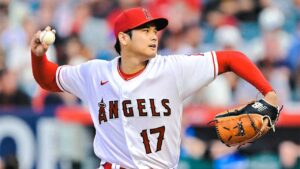
Influences and legacy of Shohei Otani’s Nippon Ham era
During his time with the Nippon-Ham Fighters, Shohei Otani not only achieved great results, but also had a great impact both inside and outside the team.
His presence also played an important role in the team’s leadership and contributions to the Japanese baseball world as a whole.
Below, we will take a closer look at Shohei Ohtani’s leadership within the team and his contributions to Japanese baseball.
Leadership within a team
Although young, Shohei Otani demonstrated strong leadership as a member of the Nippon-Ham Fighters.
His playing style and effort were a great inspiration to his teammates and boosted the morale of the entire team.
Otani always had a high level of professionalism and spared no effort to maximize his performance.
His attitude set a good example for young players and had a positive impact on the practice environment and atmosphere of the entire team.
He also has excellent communication skills, and by sharing technical advice as a pitcher and insight as a hitter with his teammates, he contributed to the improvement of the team’s overall technique.
Especially in the 2016 Japan Series, Otani’s leadership stood out.
His performance in both pitching and hitting was a great source of strength for the team, leading them to victory in the Japan Series.
More than just his performance, his leadership had a huge impact on his teammates and fans.
Contribution to the Japanese baseball world and expectations for the future
Shohei Otani’s contribution to the Japanese baseball world is immeasurable. His “two-way” playing style showed many young players new possibilities.
Ohtani’s success has proven that it is possible to play both as a pitcher and a hitter, breaking traditional stereotypes.
Additionally, Otani’s presence was a factor in increasing the international attention of Nippon Professional Baseball.
His performance was widely covered by the domestic and international media, and became a great example of how capable Japanese baseball players are on the world stage.
In particular, his success after competing in the Major Leagues was a great source of encouragement for young Japanese players, and gave them an opportunity to dream of playing overseas in the future.
Furthermore, Otani’s influence extends beyond just professional athletes to amateur athletes and children.
His success story has become an aspiration for many youth baseball players and is a factor that increases their passion for baseball.
In addition, the training and techniques practiced by Otani have been adopted by many coaches and are helping to develop the next generation of athletes.
The influence of Shohei Ohtani’s time at Nippon Ham is not limited to his individual results.
His presence demonstrated leadership within the team and made significant contributions to the Japanese baseball world as a whole.
Otani’s influence will continue, and many young players will continue to grow by following in his footsteps.
Shohei Otani’s legacy will forever shine in the world of Japanese baseball.

Interacting with fans and the importance of uniform numbers
During his time with the Nippon-Ham Fighters, Shohei Ohtani was not only a great player, but also focused on building strong bonds with fans.
The number 11 on his back is a symbol of this, and it played an important role in interacting with and supporting fans.
Below, we will take a closer look at the relationship between fan service and uniform numbers, and what the uniform number “11” symbolizes.
The relationship between fan service and uniform numbers
Shohei Otani is a player who places great value on fan service, and has actively interacted with fans, such as signing autographs and taking photos after games.
His sincere attitude touched many fans, and his uniform number 11 has taken on a special meaning for them.
The jersey number “11” was inherited from former ace Yu Darvish, and it was also very important to Otani himself.
Through this jersey number, Otani has deepened his bond with his fans, who have come to support his successes even more.
In particular, the sight of fans wearing uniforms with the number “11” gathering in the stands and cheering on Ohtani during and after the game was a sight that symbolized the unity of the Nippon Ham Fighters.
Additionally, Otani’s fan service reflects his sincere personality, and fans were impressed by his attitude.
His jersey number, “11,” has more meaning to fans than just a number, and is widely recognized as a symbol of Ohtani’s playing style and personality.
What the uniform number 11 symbolizes
Uniform number 11 has a special meaning for Shohei Otani.
This number was the one he inherited when he turned professional and has played an important role in his career.
The number 11 on his back symbolizes Otani’s talent, hard work, and spirit.
By inheriting this number previously used by Yu Darvish, Otani was burdened with great pressure and expectations.
However, he lived up to those expectations and took on the uniform number 11 with outstanding results.
This jersey number has come to symbolize the many accomplishments he achieved with the Nippon-Ham Fighters.
Furthermore, the uniform number “11” also symbolizes Otani’s challenge as a “dual wielder.”
Otani’s ability as both a pitcher and a batter made a strong impression on fans through this number.
His success in both pitching and hitting brought a breath of fresh air to the Japanese professional baseball world, and he became a role model for many young players.
Additionally, the uniform number “11” continued to hold special meaning for Ohtani when he challenged himself to the major leagues.
His jersey number has become a symbol of Ohtani’s hard work and success for fans, giving them a reason to continue cheering him on wherever he goes.
Shohei Ohtani’s uniform number 11 symbolizes his success and hard work during his time at Nippon Ham, as well as his deep bond with fans.
Through this number, he continued to be loved by many fans and its importance grew along with his career.
This number will continue to remain in the hearts of fans as a symbol of the player Shohei Ohtani.

Shohei Otani’s results and future outlook
Shohei Ohtani achieved outstanding results during his time with the Nippon-Ham Fighters, which led to success in the major leagues.
His results are indicative of his future potential and his performance is something to look forward to.
Below, we will take a closer look at the potential that can be seen from his performance during his time with Nippon-Ham and the relationship with his success in the major leagues.
Possibilities seen from results during Nippon-Ham era
Shohei Ohtani’s performance with the Nippon Ham Fighters clearly demonstrates his versatility and excellent performance.
His success in both pitching and hitting became the foundation for his success as a “two-way player.”
Results as a pitcher
Otani pitched in a total of 85 games in five seasons with Nippon-Ham, posting a record of 42 wins, 15 losses, an ERA of 2.52, and 624 strikeouts.
In particular, his 1.86 ERA in 2016 shows how good a pitcher he is.
Additionally, in 2015, he recorded an excellent record of 15 wins, 5 losses, and an ERA of 2.24, proving his ability.
Results as a batter
As a hitter, Ohtani also achieved great results.
He played in 403 games over five seasons, posting a .286 batting average, 48 home runs, and 166 RBIs.
In particular, in the 2016 season, he achieved career highs with a batting average of .322, 22 home runs, and 67 RBIs, showing his ability as a first-class hitter.
These results laid the foundation for Otani’s success as a “two-way player” and increased his confidence and motivation for his subsequent challenge in the major leagues.
Relationship with success in the major leagues
Shohei Ohtani’s performance with the Nippon Ham Fighters is closely related to his subsequent success in the major leagues.
How did his experience and accomplishments in Japan influence his performance in the major leagues?
Major League Challenge
Ohtani moved to the Los Angeles Angels in 2018 and began his major league career.
His performance and experience in Japan made an immediate impact in the major leagues, where he excelled in both hitting and pitching.
In particular, his fastball and slider made him a formidable weapon for major league batters, and his pitching was highly praised.
Active in both pitching and hitting
Even in the Major Leagues, Ohtani has achieved excellent results as both a pitcher and a batter.
In the 2018 season, he had a record of 4 wins, 2 losses, an ERA of 3.31, and 63 strikeouts as a pitcher, and a batting average of .285, 22 home runs, and 61 RBIs as a batter.
In this way, he utilized his experience in Japan in the major leagues, establishing himself as a “two-way player.”
Future prospects
Shohei Otani’s future prospects are very bright.
His experience in Japan and success in Major League Baseball provide the foundation for his further development and success at a higher level.
His goal is more success in the major leagues and becoming the best player in the world.
His performance in both pitching and hitting will continue to fascinate many fans.
Otani’s success is also a great source of encouragement for young Japanese players, and his influence is expected to continue to play an important role in Japanese baseball.
His career will give dreams and hope to young players and contribute to the future development of baseball in Japan.
Shohei Otani’s results during his time with Nippon-Ham and his success in the Major Leagues are the fruit of his talent and hard work, and there is no doubt that his success will continue to attract attention.
His performance and future outlook will continue to be an interesting topic for baseball fans around the world.
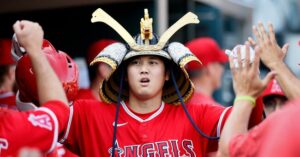
Looking back at the Nippon Ham era
Shohei Ohtani’s time with the Nippon-Ham Fighters was an unforgettable period for many fans.
His amazing performance and personality moved and delighted many fans.
Here, we will take a closer look at messages and voices of gratitude from fans, as well as Shohei Otani’s own reflections and comments.
Messages and thanks from fans
After Shohei Ohtani left the Nippon-Ham Fighters, many fans expressed their gratitude towards him.
Not only his great play, but also his sincere attitude and hard work captured the hearts of the fans.
Below are some of the main messages and words of gratitude sent by fans.
“Mr. Otani, it was a pleasure to watch you play every day. We, the fans, are proud of your growth and success at Nippon-Ham.”
“Shohei-san, I’m impressed by your sincere attitude and effort. Please do your best in the Major League as well. I’m rooting for you!”
“Thank you, Otani, for the wonderful memories you had at Nippon-Ham. Your presence was special to both the team and the fans.”
As you can see from these messages, Shohei Otani was loved and appreciated by many fans.
His performance was a joy for fans and his time with Nippon Ham will be remembered by many.
Shohei Otani’s own reflections and comments
Shohei Ohtani himself looks back on his time with the Nippon-Ham Fighters and remembers that period with much gratitude.
Below are some of Shohei Ohtani’s key comments about his experience with Nippon Ham:
“My time at Nippon-Ham was extremely valuable to me. I received a lot of support from my teammates, coaches, staff, and fans.”
“I’m grateful for the opportunity to play as a two-way player. I wouldn’t be where I am today without this experience.”
“The support from the fans was a great source of encouragement for me. I am always grateful for the support and messages at the stadium.”
Shohei Ohtani has emphasized that his experience with Nippon Ham was extremely important to his career.
He says he wouldn’t be as successful as he is without the support from his teammates, coaches and fans.
He also expressed his strong gratitude to the Nippon-Ham Fighters, who recognized and supported his play as a two-way player.
Shohei Otani’s time with Nippon Ham was a special time for both him and his fans, and the memories will remain forever.
His success is the result of the support and efforts of many people, and his growth has greatly contributed to the development of Japanese baseball as a whole.
The fans who will continue to watch and support Shohei Otani will continue to enjoy his success and look forward to his next challenge.

